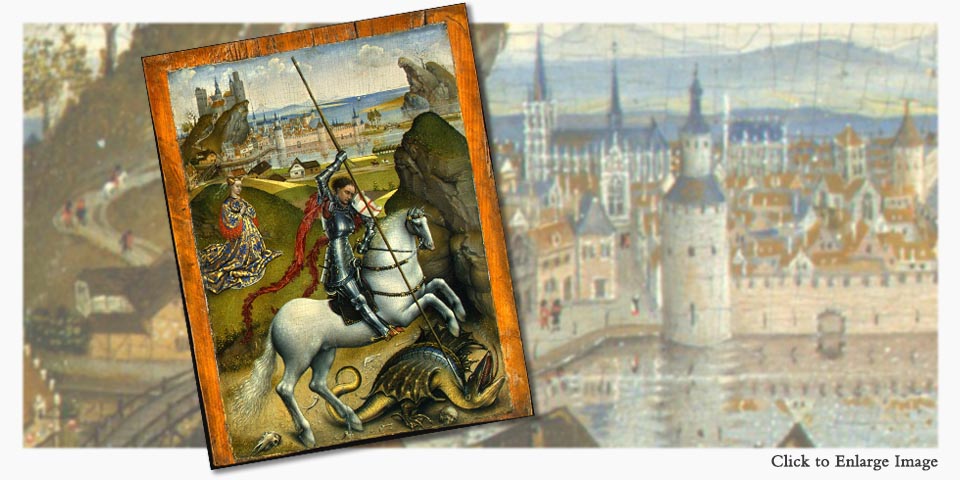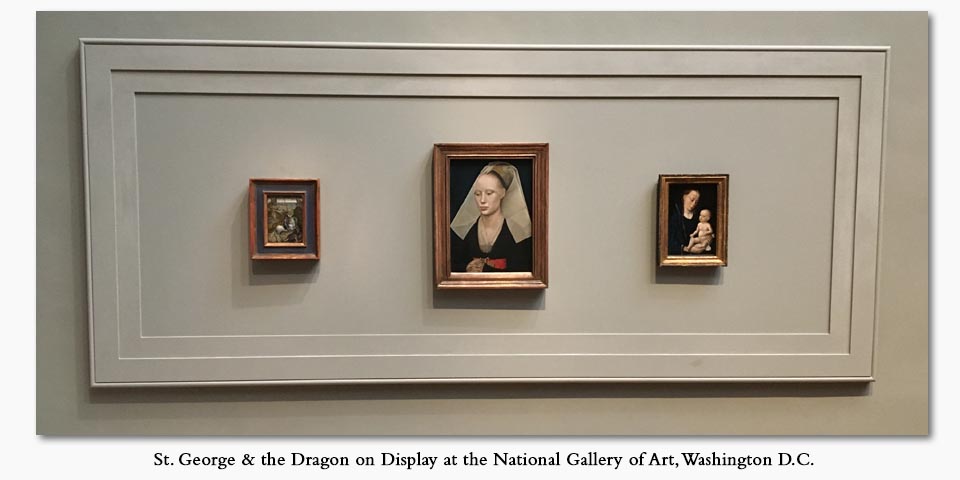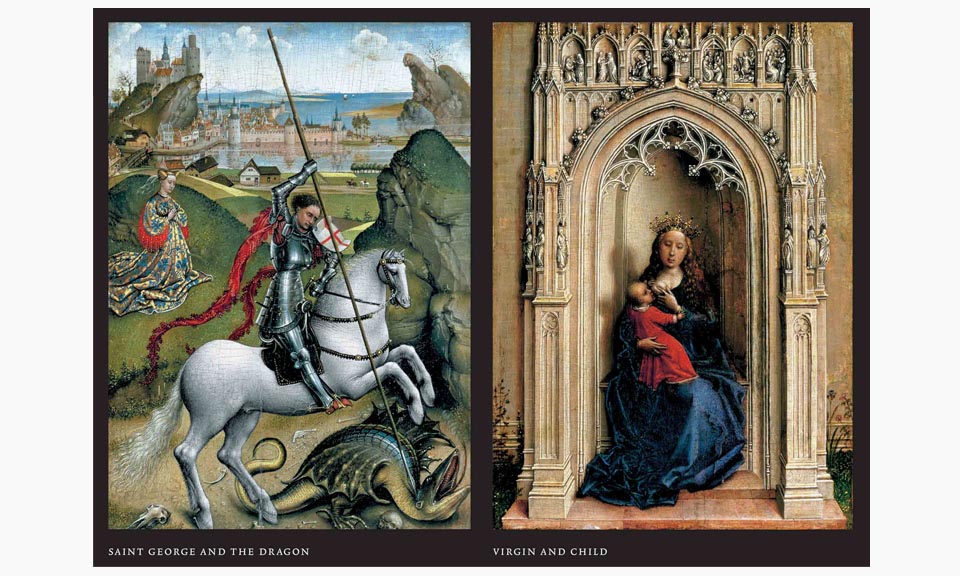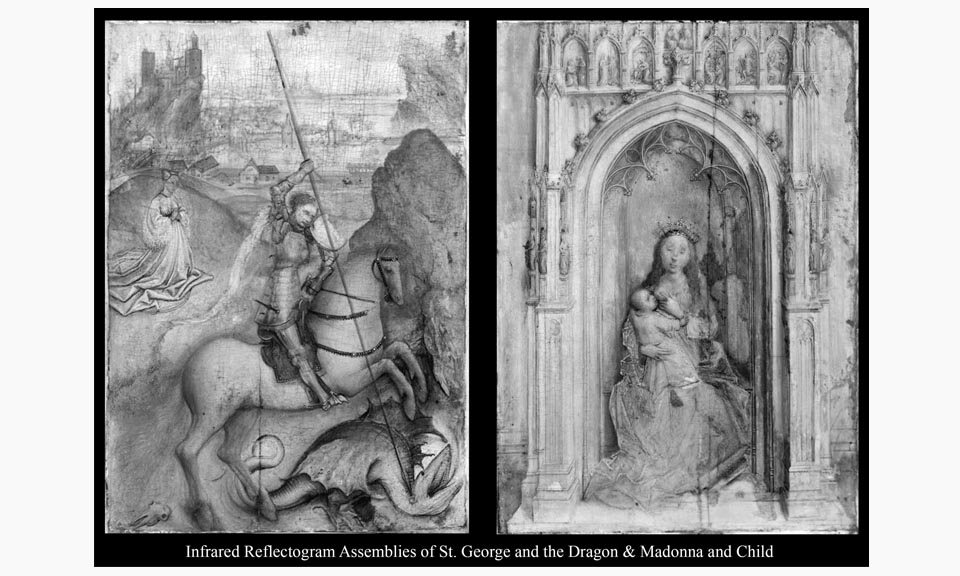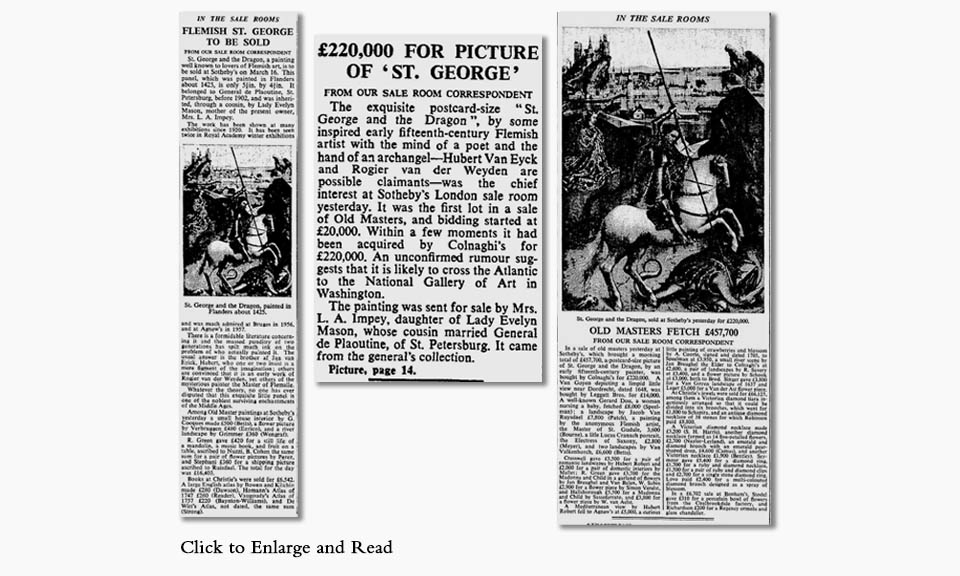St. George and the Dragon: From Russia to Washington D.C.
On display in the West Building (Main Floor, Gallery 39) of the National Gallery of Art in Washington D.C. is a small oil painting of St. George and the Dragon. The painting itself is small, measuring just 6x4-5/8", making it the size of a postcard or standard photograph. For many years the painting was thought to have been executed by Hubert or Jan van Eyck (among a few other guesses), but is now attributed to the renowned artist Rogier van der Weyden and dated c. 1432/1435. Though this attribution is hotly contested in the art world, the curator of the NGA sums it up by saying, "We can't prove it's Rogier, but it's the most useful name with which to associate it." Considered an astonishing gem in the NGA collection, St. George is easy to pass over due to its small size. But the story behind this little piece is truly fascinating!
Provenance on this piece has been almost impossible to ascertain, due to the very roundabout way in which it arrived at auction at Sotheby's in March 1966. Due to a surviving seal in the lower right corner of the panel's reverse, the painting is believed to have belonged to the affluent Polish family of Grudna-Grudzinski — possibly entering Russia through a daughter of that house, Joanna, wife of Grand Duke Constantine of Russia. The first documentation in any art catalogs or magazines shows the picture in the collection of General de Plaoutine of St. Petersburg as of 1900, but it is not until 1920 that it surfaces in London at an exhibition of the Burlington Fine Arts Club. So, how did this treasure arrive in England? Decades later, memoirs have now surfaced, written by Eleanor Jauncey (the niece of General Plaoutine), which fill in the odd gaps to this story.
From childhood, Eleanor loved art. This was a passion that she shared with her Russian uncle, Serge Plaoutine. Together they visited museums, galleries and shops — and it is a memory of one of these trips that we read here, bearing in mind that Eleanor could be no more than nine years old at this time (click the button below to read her complete memories about St. George and the Dragon):
My aunt, Eleanor Pringle, married Serge Plaoutine, A.D.C. to the Tsar. He was a dear man but not a typical Russian. After he retired and they lived in St. Petersburg, on the Neva, opposite the well-known tower and prison of the Peter and Paul Fortress, we liked looking in shops for curios. On one such outing, Uncle Serge found – in a shabby little second-hand shop – an old painting of St. George slaying the Dragon and paid 90 roubles for it. It was a tiny St. George & Dragon – no larger than a postcard.
This small visit was no later than 1900, since the painting was seen in Serge's collection by that time. When he retired in 1914, the General and his wife moved to France, not knowing that they would never see their home again due to the Russian Revolution. Serge had brought only a few of his art treasures to Nice, but St. George and the Dragon was one of those few! With the loss of all his property and income in Russia, the now impoverished General was forced to sell off his art one piece at a time. He entrusted the small picture to his niece, Eleanor, and her mother in the Spring of 1915. They packed St. George into their luggage, returned to their own home in England and enlisted the aid of a cousin in selling the painting. This cousin was Lady Evelyn Mason, daughter of the Earl of Crawford, and it was through her that the picture was displayed at the Burlington Fine Arts Club.
Despite the family's best efforts, the painting could not be sold. Two leading "critics in pictures" argued over the name of the artist of St. George, each attributing the painting to a different artist. The market value was killed and no buyer could be found. To help her struggling cousins, Lady Evelyn purchased the picture herself at the sum of £1,500, and the money was gratefully accepted by the Plaoutines. At her death in 1944, Lady Evelyn's daughter, Joan Impey, inherited the painting, now long forgotten in the art world.
Finally, in 1966, the painting was again brought into the limelight when Mrs. Impey sold it through a large art auction at Sotheby's. It was the highlight of the auction and the first item on the block, bringing in the astonishing sum of £220,000. (Sadly, the Impey family shared just £100 pounds with the surviving family of General Plaoutine.) Purchased by Colnaghi's for the National Art Gallery in Washington D.C., the picture was soon on its way to the United States where it has been on display ever since. It now hangs beside Rogier van der Weyden's "Portrait of a Lady" and Dirick Bouts' "Madonna and Child". So, if you have the chance to see this painting in person, just think about the little girl and her uncle who found this treasure in an old curio shop somewhere in St. Petersburg . . .

The following is a timeline, charting the whereabouts of St. George and the Dragon through the years, particularly during its time with the Plaoutines and their family. (For further attribution and exhibition dates, see this page of the NGA website.)
1894-1900
EV remembers being with "Uncle Serge" (Serge Plaoutine) when he purchased the painting for 90 roubles. The 1899 exchange rate was £1 = 6.28 rubles (1 ruble = £.16), making for a purchase price of approximately £14.4.
1900
In 1912, Sir Claude Phillips reported having seen the painting in Serge's collection at the St. Petersburg house in 1900.
1912
In 1966, Illustrated London News published that Serge removed the painting to Nice in 1912.
1914
In her memoirs, Mariamne Smith, Serge's granddaughter, claims that it was removed to Nice in 1914.
SPRING 1915
EV Jauncey, Serge's niece, states that she and her mother carried the painting from Nice to England, with the intent to raise money for Uncle Serge by its sale.
1920
Displayed at an exhibition of the Burlington Fine Arts Club, a London gentlemen's club based at 17 Savile Row, London: Pictures and English Furniture of the Chippendale Period. Loaned by Serge Plaoutine.
1923
Purchased from Serge Plaoutine by Lady Evelyn Mason. Purchase price: £1,500.
1966
March 16. Sold by Evelyn Mason's daughter, Mrs. Joan Impey, to the American National Gallery of Art, for £220,000.
In 1984, Mrs. Joan Impey (who had sold the painting in 1966) claimed that it had been removed to Nice in 1917 and sent on to the US some time after that, but she had been misinformed.

Prayers and Portraits: Understanding the Netherlandish Diptych
Extensive study was done on this painting before the 2006 NGA exhibition, "Prayers and Portraits: Understanding the Netherlandish Diptych". Infrared examination showed evidence that St. George was once part of a Diptych featuring an unattributed "Virgin and Child" panel (now part of the Museo Thyssen-Bornemisza, Madrid) on its verso.
An extensive catalogue and study of all the art pieces display was published in book form (Yale University Press, 2006) and is available online in PDF format. The following extract is their short article on the St. George painting, which begins on page 240:
It has long been acknowledged that these small, exquisite paintings are associated with one another. They are virtually identical in size, and both have been thinned and set into other panels. Seals on their reverses indicate that at some point they were together in Berlin. What has not been at all clear, however, is the original relationship between the two. Were they separate wings of a diptych or possibly part of a small triptych? If they did form a diptych, how would one explain the awkward juxtaposition of a colorful Saint George in a landscape against a somewhat monochromatic Virgin and Child in a niche?
An answer to these questions was provided by our technical examination, which established with a very high degree of probability that Saint George and the Dragon and the Virgin and Child were originally part of a single panel. Infrared reflectogram assemblies reveal a crack in the Saint George and the Dragon support that extends upward from the bottom of the panel through the tail of the dragon and well into the flank of the horse. This crack corresponds exactly, in a mirroring position, to a crack that extends vertically through the Virgin and Child. It is thus all but certain that these two paintings initially formed the front and back of a single panel, which might well have been one wing of a diptych. It is impossible to know what might have been depicted on the other panel.
The phrase "multum in parvo" applies equally to both paintings, for both are triumphs of observation and symbolic meaning. Saint George, the embodiment of Christian chivalry, slays a dragon and rescues a princess in a landscape filled with water, buildings, and minute figures that seems to offer infinite possibilities for exploration, down to the tiny ships on the horizon. No less astonishing in detail, the Madrid picture shows the Virgin wearing a crown and offering her breast to the Christ child, seated in a niched that resembles the portal of a Gothic church. Flanking them are depicted six tiny sculpted figures, probably intended as prophets, although only David with his harp can be identified in the center of the group on the left. A seventh figure, to the right of the latter group, was prepared in the underdrawing but never executed in paint. In the arches overhead are minute representation of the Annunciation, Visitation, Nativity, Adoration of the Magi, the Resurrection, and Pentecost. In the center is the heavenly coronation and blessing of Mary by Christ. The flowers at either side of the niche have been identified, and the iris, carnation, and columbine, like the Christ child's red robe, refer to the Passion. Not only is the Virgin equated with the Church and incarnation of Christ here, but as several authors have noted, she is also the Queen of Heaven and mystical Bride of Christ.
At various times the Madrid and Washington panels have been attributed to Hubert van Eyck and Robert Campin, and the Saint George and the Dragon has been associated with a lost painting of the same subject by Jan van Eyck. The prevailing opinion, however, is that these are early works by Rogier van der Weyden, perhaps dating toward the end or just after his apprenticeship with Campin. The influence of the older artist is apparent in the facial types of Saint George and the Virgin, while the brilliant light effects, such as the reflections on the saint's armor and the dragon's scales, bespeak an acquaintance with the art of Jan van Eyck. Not everyone accepts Rogier's authorship, but although caution is always advisable, it is hard to image another artist capable of achieving such a high quality of execution.
The close relationship between the Washington and Madrid panels is further supported by the underdrawings, which are quite comparable in style and method. The contours of the main features in the compositions as well as some areas of shading were prepared with relatively broad strokes in a liquid medium, and several small and larger changes between the underdrawing and the final painting were revealed in both panels. The underdrawings for these two works are not incongruent with those for other panels in the Rogier van der Weyden group, although the exceptionally small scale impedes closed comparison.


